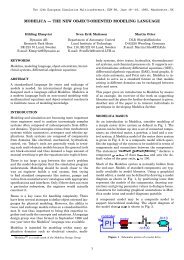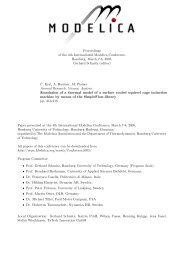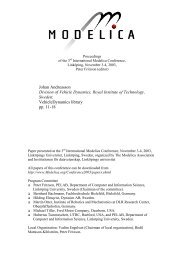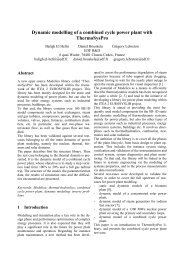Using Modelica and Control Systems for Real-time Simulations in ...
Using Modelica and Control Systems for Real-time Simulations in ...
Using Modelica and Control Systems for Real-time Simulations in ...
Create successful ePaper yourself
Turn your PDF publications into a flip-book with our unique Google optimized e-Paper software.
Proceed<strong>in</strong>gs<br />
of the 4th International <strong>Modelica</strong> Conference,<br />
Hamburg, March 7-8, 2005,<br />
Gerhard Schmitz (editor)<br />
J. Bäckman, M. Edvall<br />
Metso Paper AB, Sweden<br />
<strong>Us<strong>in</strong>g</strong> <strong>Modelica</strong> <strong>and</strong> <strong>Control</strong> <strong>Systems</strong> <strong>for</strong> <strong>Real</strong>-<strong>time</strong> <strong>Simulations</strong> <strong>in</strong> the Pulp<br />
pp. 579-583<br />
Paper presented at the 4th International <strong>Modelica</strong> Conference, March 7-8, 2005,<br />
Hamburg University of Technology, Hamburg-Harburg, Germany,<br />
organized by The <strong>Modelica</strong> Association <strong>and</strong> the Department of Thermodynamics, Hamburg University<br />
of Technology<br />
All papers of this conference can be downloaded from<br />
http://www.<strong>Modelica</strong>.org/events/Conference2005/<br />
Program Committee<br />
• Prof. Gerhard Schmitz, Hamburg University of Technology, Germany (Program chair).<br />
• Prof. Bernhard Bachmann, University of Applied Sciences Bielefeld, Germany.<br />
• Dr. Francesco Casella, Politecnico di Milano, Italy.<br />
• Dr. Hild<strong>in</strong>g Elmqvist, Dynasim AB, Sweden.<br />
• Prof. Peter Fritzson, University of L<strong>in</strong>kp<strong>in</strong>g, Sweden<br />
• Prof. Mart<strong>in</strong> Otter, DLR, Germany<br />
• Dr. Michael Tiller, Ford Motor Company, USA<br />
• Dr. Hubertus Tummescheit, Scynamics HB, Sweden<br />
Local Organization: Gerhard Schmitz, Katr<strong>in</strong> Prölß, Wilson Casas, Henn<strong>in</strong>g Knigge, Jens Vasel, Stefan<br />
Wischhusen, TuTech Innovation GmbH
<strong>Us<strong>in</strong>g</strong> <strong>Modelica</strong> <strong>and</strong> <strong>Control</strong> <strong>Systems</strong> <strong>for</strong> <strong>Real</strong>-<strong>time</strong> <strong>Simulations</strong><br />
<strong>in</strong> the Pulp & Paper <strong>in</strong>dustry<br />
Abstract<br />
Johan Bäckman Mattias Edvall<br />
Metso Paper Sundsvall AB<br />
851 94 Sundsvall, SWEDEN<br />
johan.backman@metso.com mattias.edvall@metso.com<br />
Metso Paper regularly uses process simulations when<br />
design<strong>in</strong>g <strong>and</strong> deliver<strong>in</strong>g a new pulp mill. The<br />
simulations have two ma<strong>in</strong> purposes. Operators are<br />
tra<strong>in</strong>ed <strong>in</strong> runn<strong>in</strong>g the new process be<strong>for</strong>e it exists<br />
<strong>and</strong> complex control logic can be validated efficiently<br />
be<strong>for</strong>e start-up. The simulations are built us<strong>in</strong>g<br />
Dymola/<strong>Modelica</strong>, executed <strong>in</strong> real-<strong>time</strong> <strong>and</strong><br />
connected to the plant's control system.<br />
This paper will discuss the general technical solution<br />
<strong>for</strong> us<strong>in</strong>g Dymola/<strong>Modelica</strong> <strong>in</strong> comb<strong>in</strong>ation with a<br />
control system <strong>for</strong> real-<strong>time</strong> simulations. The paper<br />
will also provide an overview of the different applications<br />
that Metso Paper has implemented. Expectations<br />
of future development of <strong>Modelica</strong> <strong>and</strong> connected<br />
software will be discussed from an <strong>in</strong>dustry<br />
perspective.<br />
Keywords: dynamic simulation; control system; pulp<br />
<strong>and</strong> paper; operator tra<strong>in</strong><strong>in</strong>g; logic verification<br />
1 Introduction<br />
<strong>Us<strong>in</strong>g</strong> <strong>Modelica</strong> <strong>and</strong> <strong>Control</strong> <strong>Systems</strong> <strong>for</strong> <strong>Real</strong>-<strong>time</strong> <strong>Simulations</strong> <strong>in</strong> the Pulp & Paper <strong>in</strong>dustry<br />
Different k<strong>in</strong>ds of simulations are used with<strong>in</strong> Metso<br />
Paper <strong>for</strong> design<strong>in</strong>g <strong>and</strong> develop<strong>in</strong>g the pulp <strong>and</strong> paper<br />
processes. Static simulations <strong>for</strong> balanc<strong>in</strong>g <strong>and</strong><br />
dimension<strong>in</strong>g the process with respect to flows,<br />
steam, chemicals etc. The second type is advanced<br />
<strong>and</strong> computational dem<strong>and</strong><strong>in</strong>g FEM-type of simulations<br />
<strong>for</strong> more detailed simulations <strong>and</strong> analyses of<br />
different optional mach<strong>in</strong>e designs. The third type of<br />
simulations is the real-<strong>time</strong> dynamic process simulator<br />
<strong>for</strong> operator tra<strong>in</strong><strong>in</strong>g <strong>and</strong> control system verification.<br />
This paper will focus on the real-<strong>time</strong> dynamic<br />
process simulations. A tra<strong>in</strong><strong>in</strong>g session us<strong>in</strong>g<br />
simulators is shown <strong>in</strong> Figure 1.<br />
Figure 1. Simulator tra<strong>in</strong><strong>in</strong>g <strong>in</strong> progress<br />
When deliver<strong>in</strong>g a new mach<strong>in</strong>e, process area or a<br />
complete mill Metso Paper has offered dynamic process<br />
simulations s<strong>in</strong>ce beg<strong>in</strong>n<strong>in</strong>g of the 1990's. The<br />
ma<strong>in</strong> purpose of these simulations is to tra<strong>in</strong> operators<br />
<strong>and</strong> other mill personnel <strong>in</strong> runn<strong>in</strong>g the new<br />
equipment <strong>in</strong> an efficient <strong>and</strong> optimal way. The operators<br />
get used to the new operator displays, <strong>in</strong>terlock<strong>in</strong>g<br />
logic <strong>and</strong> most importantly new process dynamics.<br />
Difficult <strong>and</strong> rare process conditions can be<br />
<strong>in</strong>troduced <strong>in</strong> the simulations. By regularly expos<strong>in</strong>g<br />
the mill personnel to these difficult situations <strong>in</strong> the<br />
simulator environment, expensive <strong>and</strong> unwanted<br />
stops <strong>in</strong> the real production can be avoided.<br />
Earlier these types of simulations were made <strong>in</strong> a<br />
s<strong>in</strong>gle PC where the process simulations as well as a<br />
mimic of the real operator displays <strong>and</strong> the plant's<br />
control system was configured. Even if this system<br />
worked f<strong>in</strong>e technically speak<strong>in</strong>g <strong>and</strong> served its purpose<br />
as an educational tool, it had some drawbacks.<br />
The two major problems with this solution were:<br />
• It was a very expensive solution due to the many<br />
eng<strong>in</strong>eer<strong>in</strong>g hours needed <strong>in</strong> order to convert the<br />
real operator displays <strong>and</strong> control logic <strong>in</strong>to the<br />
simulator world. When new revisions of displays<br />
<strong>and</strong> control logic were made, new revisions must<br />
The <strong>Modelica</strong> Association 579 <strong>Modelica</strong> 2005, March 7-8, 2005
J. Bäckman, M. Edvall<br />
be made <strong>in</strong> the simulator as well. On top of this,<br />
it was very difficult to reuse models <strong>and</strong> configurations<br />
between projects.<br />
• It was difficult to keep the simulator up to date<br />
once delivered to a customer s<strong>in</strong>ce every change<br />
<strong>in</strong> the real control system <strong>and</strong> operator displays<br />
must be followed by a correspond<strong>in</strong>g change <strong>in</strong><br />
the simulator system. Typically, the changes <strong>in</strong><br />
the real process were done by the mill personnel<br />
while changes <strong>in</strong> the simulator dem<strong>and</strong>ed <strong>in</strong>volvement<br />
from other competencies. In practice<br />
the simulator <strong>and</strong> real world configurations<br />
slowly drifted apart.<br />
Start<strong>in</strong>g <strong>in</strong> beg<strong>in</strong>n<strong>in</strong>g of year 2001 a new architecture<br />
<strong>for</strong> dynamic process simulations with<strong>in</strong> Metso Paper<br />
were developed us<strong>in</strong>g <strong>Modelica</strong> <strong>and</strong> Dymola. The<br />
ma<strong>in</strong> difference between the old <strong>and</strong> new architecture<br />
is that <strong>in</strong> the new architecture the real control<br />
system <strong>and</strong> real operator displays are used <strong>in</strong>stead of<br />
<strong>in</strong>clud<strong>in</strong>g a mimic version of the two <strong>in</strong>to the simulator.<br />
The simulation models are also designed <strong>in</strong> a<br />
way that modular build<strong>in</strong>g blocks of typical process<br />
equipment <strong>and</strong> areas easily can be reused from project<br />
to project. The advantages of the new architecture<br />
are substantial<br />
• S<strong>in</strong>ce no mimic is done of the operator displays<br />
<strong>and</strong> control logic the eng<strong>in</strong>eer<strong>in</strong>g hours has reduced<br />
dramatically. The modular design of the<br />
new simulation models has also contributed to<br />
lower the eng<strong>in</strong>eer<strong>in</strong>g hours s<strong>in</strong>ce much can be<br />
reused from project to project. The operators get<br />
to use the real displays <strong>and</strong> real control system<br />
when do<strong>in</strong>g simulator tra<strong>in</strong><strong>in</strong>g, <strong>and</strong> no changes<br />
needs to be made <strong>in</strong> the simulator when changes<br />
are made to the displays <strong>and</strong> control logic.<br />
• It is much easier to keep the simulator system up<br />
to date s<strong>in</strong>ce the real control system is used.<br />
Changes made to the displays <strong>and</strong> control logic<br />
can be transferred <strong>in</strong>to the simulator system directly<br />
by the mill personnel.<br />
Another big advantage with the new architecture is<br />
that the simulator system can be used to validate the<br />
upper level control system <strong>and</strong> mill control system<br />
be<strong>for</strong>e start-up. This has traditionally been a very<br />
<strong>time</strong> <strong>and</strong> resource-consum<strong>in</strong>g task <strong>and</strong> even then, the<br />
quality of the validation has been difficult to verify<br />
due to the complexity of the control logic. Errors <strong>in</strong><br />
the control system, as well as <strong>in</strong> the dimension<strong>in</strong>g of<br />
process equipment, are corrected easily <strong>and</strong> effectively<br />
early <strong>in</strong> the projects. Considerably reductions<br />
<strong>in</strong> test <strong>time</strong> have been noticed s<strong>in</strong>ce start<strong>in</strong>g us<strong>in</strong>g<br />
simulators <strong>for</strong> test purposes. As the simulations get<br />
more accurate it is also possible <strong>in</strong> some areas to pretune<br />
PID controllers us<strong>in</strong>g the simulator. Start<strong>in</strong>g the<br />
real mill with verified control logic, tra<strong>in</strong>ed operators<br />
<strong>and</strong> pre-tuned PID controllers are a great benefit <strong>for</strong><br />
Metso Paper customers.<br />
2 The Simulator system<br />
2.1 Architecture<br />
The new simulator architecture is shown <strong>in</strong> Figure 2.<br />
Simulator <strong>Control</strong> Room<br />
<strong>Control</strong> System<br />
Process Simulator<br />
Figure 2. The new simulator architecture<br />
A Metso Paper simulator system typically consists of<br />
a control system that is the same control system used<br />
to control the real process (example: metsoDNA,<br />
ABB Industrial IT, Siemens PCS7, Emerson DeltaV,<br />
The <strong>Modelica</strong> Association 580 <strong>Modelica</strong> 2005, March 7-8, 2005
etc). Another computer executes specific process<br />
simulation models <strong>in</strong> real-<strong>time</strong>. The operators are<br />
us<strong>in</strong>g the same operator displays as they would <strong>in</strong> the<br />
real control room. The system can be extended to<br />
<strong>in</strong>clude several computers that simultaneously are<br />
runn<strong>in</strong>g different simulations towards the same control<br />
system. <strong>Real</strong> control system hardware can be<br />
used to execute the control logic <strong>and</strong> operator displays.<br />
However, a modern control system usually<br />
offers a software version (example Metso's VirtualDNA)<br />
of the control system, which can be more<br />
convenient to use. Included <strong>in</strong> the control system are<br />
all control logic, graphical displays, PID controllers,<br />
alarm limits, <strong>in</strong>terlock<strong>in</strong>g diagrams, trend displays<br />
etc. Everyth<strong>in</strong>g that an operator will have once runn<strong>in</strong>g<br />
the real process is already there s<strong>in</strong>ce it is the<br />
same system be<strong>in</strong>g used.<br />
2.2 Models<br />
<strong>Us<strong>in</strong>g</strong> <strong>Modelica</strong> <strong>and</strong> <strong>Control</strong> <strong>Systems</strong> <strong>for</strong> <strong>Real</strong>-<strong>time</strong> <strong>Simulations</strong> <strong>in</strong> the Pulp & Paper <strong>in</strong>dustry<br />
<strong>Us<strong>in</strong>g</strong> <strong>Modelica</strong> <strong>and</strong> Dymola a specific model library<br />
has been developed <strong>in</strong>clud<strong>in</strong>g models that make it<br />
possible to build complete simulations of Metso Paper<br />
mach<strong>in</strong>es <strong>and</strong> processes. Examples are Super-<br />
Batch TM cook<strong>in</strong>g, Wash<strong>in</strong>g <strong>and</strong> Screen<strong>in</strong>g, Ref<strong>in</strong><strong>in</strong>g,<br />
Pulp Bleach<strong>in</strong>g <strong>and</strong> Pulp Dry<strong>in</strong>g area. In Figure 3 a<br />
small part of the wash<strong>in</strong>g <strong>and</strong> delignification process<br />
can be seen.<br />
Figure 3. A part of pulp mak<strong>in</strong>g process<br />
The library <strong>in</strong>cludes models of Metso Paper specific<br />
mach<strong>in</strong>ery such as SuperBatch TM digesters, Delta-<br />
Combi TM screens, Ref<strong>in</strong>ers, Tw<strong>in</strong>Roll TM presses,<br />
OxyTrac TM delignification towers <strong>and</strong> Pulp Dry<strong>in</strong>g<br />
mach<strong>in</strong>es, but also more general equipment such as<br />
valves, pumps, pipes, heat exchangers, tanks, etc.<br />
Together the models are used to build up simulations<br />
of complete pulp mills. Creat<strong>in</strong>g a large net of equations<br />
def<strong>in</strong><strong>in</strong>g the flows, pressures, temperatures,<br />
chemical consumption, pulp consistency <strong>and</strong> other<br />
process values, all values will react depend<strong>in</strong>g upon<br />
the actions taken by the operator us<strong>in</strong>g the control<br />
system. A complete simulation <strong>in</strong>cludes all process<br />
mach<strong>in</strong>ery <strong>and</strong> <strong>in</strong>strumentation, starts with chips enter<br />
the digester area, <strong>and</strong> f<strong>in</strong>ish when dried <strong>and</strong><br />
bleached pulp exits the dry<strong>in</strong>g mach<strong>in</strong>e.<br />
2.3 Communication<br />
The simulation models are compiled with Dymola<br />
<strong>for</strong>m<strong>in</strong>g a W<strong>in</strong>dows application that is used as a real<strong>time</strong><br />
DDE Server. Modern control systems offer an<br />
OPC Server <strong>in</strong> order to open communication with<br />
any OPC Client. The Metso Paper simulator system<br />
<strong>in</strong>cludes special software to transfer the signals from<br />
the DDE Server <strong>in</strong> the run-<strong>time</strong> simulation to the<br />
OPC Server <strong>in</strong> the control system. S<strong>in</strong>ce practically<br />
all modern control systems have opened up to OPC<br />
technology the communication l<strong>in</strong>k can be used<br />
without changes no matter what control system the<br />
customer selects. The only configuration that needs<br />
to be done is a cross-reference list between the signal<br />
names <strong>in</strong> the simulator <strong>and</strong> the correspond<strong>in</strong>g signal<br />
names <strong>in</strong> the control system. Typically are process<br />
values like flows, pressures, temperatures, pH, consistencies<br />
etc, sent from the simulations to the control<br />
system. The control system writes values like<br />
valve open<strong>in</strong>gs, start<strong>in</strong>g orders <strong>for</strong> pumps <strong>and</strong> motors<br />
etc, back to the simulation.<br />
<strong>Modelica</strong> models <strong>for</strong> I/O communication have been<br />
developed. They are us<strong>in</strong>g the <strong>in</strong>put/output qualifiers<br />
to accept values from, <strong>and</strong> to give values to, the control<br />
system via the communication l<strong>in</strong>k.<br />
2.4 Teacher <strong>in</strong>terface<br />
The extended functionality of the communication<br />
l<strong>in</strong>k <strong>in</strong>cludes an <strong>in</strong>terface <strong>for</strong> a teacher. From this<br />
software a teacher can operate the dymosim application,<br />
start, pause <strong>and</strong> stop the simulation. It is also<br />
possible to start the simulations with different <strong>in</strong>itial<br />
positions, empty tanks, almost full tanks etc. mak<strong>in</strong>g<br />
it possible to tra<strong>in</strong> how to get out of difficult process<br />
situations without los<strong>in</strong>g production.<br />
Different k<strong>in</strong>d of scenarios <strong>and</strong> disturbances can be<br />
applied to the simulations to <strong>in</strong>vestigate how operators<br />
solve <strong>and</strong> detect common process problems.<br />
Problems like drift<strong>in</strong>g process values, malfunction <strong>in</strong><br />
valves, bl<strong>in</strong>d<strong>in</strong>g of screens, channel<strong>in</strong>g <strong>in</strong> reactors,<br />
web break <strong>in</strong> the dryer section as well as other criti<br />
The <strong>Modelica</strong> Association 581 <strong>Modelica</strong> 2005, March 7-8, 2005
J. Bäckman, M. Edvall<br />
cal situations can be tra<strong>in</strong>ed. Figure 4 shows screen<br />
displays from the teacher <strong>in</strong>terface.<br />
Figure 4. Teacher <strong>in</strong>terface<br />
A large database is used to collect data from the<br />
tra<strong>in</strong><strong>in</strong>g sessions <strong>and</strong> each operator can evaluate their<br />
actions <strong>and</strong> compare the results with earlier sessions.<br />
2.5 Per<strong>for</strong>mance<br />
Due to the complexity <strong>and</strong> scope of the process to be<br />
simulated the simulation model files <strong>and</strong> I/O communication<br />
lists becomes large. For example when<br />
simulat<strong>in</strong>g a SuperBatch TM digester area the I/O list<br />
consists of about 1800 signals, the executable simulation<br />
file is close to 40 Mb. Figure 5 shows messages<br />
from a translation of a digester area model.<br />
STATISTICS<br />
Orig<strong>in</strong>al Model<br />
Number of components: 20084<br />
Variables: 137615<br />
Constants: 1574 (0 scalars)<br />
Parameters: 35394 (69071 scalars)<br />
Unknowns: 100647 (100658 scalars)<br />
Differentiated variables: 9146 scalars<br />
Equations: 52124<br />
Nontrivial : 39885<br />
Translated Model<br />
Constants: 53502 scalars<br />
Free parameters: 17018 scalars<br />
Parameter depend<strong>in</strong>g: 19966 scalars<br />
Inputs: 0<br />
Outputs: 0<br />
Cont<strong>in</strong>uous <strong>time</strong> states: 9146 scalars<br />
Time-vary<strong>in</strong>g variables: 42482 scalars<br />
Alias variables: 24590 scalars<br />
Number of mixed real/discrete systems of equations: 18<br />
Sizes of l<strong>in</strong>ear systems of equations: {2, 2, 2}<br />
Sizes after manipulation of the l<strong>in</strong>ear systems: {0, 0, 0}<br />
Sizes of nonl<strong>in</strong>ear systems of equations: {5, 732, 35, 35, 66, 38,<br />
7, 14, 35, 7, 35, 18, 66, 18, 35, 7, 14, 35, 7, 14, 7, 7, 14, 35, 7, 35,<br />
7, 7, 5, 1, 7, 23, 6}<br />
Sizes after manipulation of the nonl<strong>in</strong>ear systems: {1, 89, 4, 4,<br />
9, 2, 1, 3, 4, 1, 4, 2, 9, 2, 4, 1, 3, 4, 1, 4, 1, 1, 3, 4, 1, 4, 1, 1, 1, 1,<br />
1, 3, 1}<br />
Number of numerical Jacobians: 0<br />
F<strong>in</strong>ished<br />
Figure 5. Translation of a digester area model<br />
The digester area is about 25% of the total pulp<strong>in</strong>g<br />
process. It is possible to run these k<strong>in</strong>ds of simulations<br />
on a PC. However, the speed of the <strong>in</strong>ternal<br />
memory bus is vital to simulation per<strong>for</strong>mance. Due<br />
to the slow nature of pulp<strong>in</strong>g processes, it is common<br />
that the simulations are run <strong>for</strong> several days without<br />
<strong>in</strong>terruptions.<br />
For tra<strong>in</strong><strong>in</strong>g purposes it is very important that the<br />
system is robust <strong>and</strong> that the accuracy is high enough<br />
<strong>for</strong> the operators to trust the simulations. However, it<br />
is important to keep <strong>in</strong> m<strong>in</strong>d that the purpose is not<br />
to simulate each process component as accurately as<br />
possible. The purpose is to produce a simulation of a<br />
large area <strong>in</strong>clud<strong>in</strong>g a large amount of equipment<br />
that will give an operator the right look <strong>and</strong> feel <strong>for</strong><br />
the dynamics <strong>in</strong> the mill.<br />
3 Practical experiences <strong>and</strong> future<br />
development<br />
Today the simulator system has been connected to<br />
the follow<strong>in</strong>g control systems: metsoDNA, ABB Industrial<br />
IT, Emerson DeltaV <strong>and</strong> Siemens PCS7.<br />
There are of course advantages <strong>and</strong> disadvantages<br />
with all of these systems when it comes to eng<strong>in</strong>eer<strong>in</strong>g<br />
efficiency <strong>and</strong> costs, but from our po<strong>in</strong>t of view;<br />
there are no technical differences. The same communication<br />
l<strong>in</strong>k has been used without modification,<br />
<strong>and</strong> the signal transferr<strong>in</strong>g between an OPC Server<br />
<strong>in</strong>cluded <strong>in</strong> the control system <strong>and</strong> the real-<strong>time</strong><br />
simulations has shown a similar per<strong>for</strong>mance with all<br />
mentioned control systems. Two complete simulator<br />
systems have been delivered so far. Figure 6 shows<br />
operator tra<strong>in</strong><strong>in</strong>g <strong>in</strong> Chile. Dur<strong>in</strong>g 2005, three more<br />
deliveries are expected.<br />
Figure 6. Simulator tra<strong>in</strong><strong>in</strong>g <strong>in</strong> Chile<br />
Dur<strong>in</strong>g the <strong>in</strong>ternal development work <strong>and</strong> practical<br />
tra<strong>in</strong><strong>in</strong>g sessions with Metso Paper customers around<br />
The <strong>Modelica</strong> Association 582 <strong>Modelica</strong> 2005, March 7-8, 2005
the world some development ideas have emerged.<br />
The ideas, if emasculated, would heavily <strong>in</strong>crease the<br />
value <strong>and</strong> competitiveness of us<strong>in</strong>g <strong>Modelica</strong> <strong>and</strong><br />
Dymola <strong>in</strong> comb<strong>in</strong>ation with control systems <strong>for</strong><br />
real-<strong>time</strong> simulations. Some of the most important<br />
areas to strengthen <strong>in</strong> order to meet <strong>in</strong>dustry dem<strong>and</strong>s<br />
<strong>in</strong> the future are as we see it:<br />
• Replac<strong>in</strong>g the Dymosim DDE Server with a<br />
modern OPC Server will open the simulation environment<br />
to all modern control systems <strong>and</strong> <strong>in</strong>crease<br />
the communication per<strong>for</strong>mance significantly.<br />
Many OPC Clients are available on the<br />
market, some even free of charge. View<strong>in</strong>g <strong>and</strong><br />
chang<strong>in</strong>g simulator values dur<strong>in</strong>g run-<strong>time</strong><br />
simulation would be facilitated.<br />
• A possibility to see <strong>and</strong> change simulation values<br />
from the model<strong>in</strong>g user <strong>in</strong>terface dur<strong>in</strong>g run-<strong>time</strong><br />
simulation would be very <strong>time</strong> sav<strong>in</strong>g <strong>and</strong> valuable<br />
dur<strong>in</strong>g development of large simulation<br />
models.<br />
• Increased debugg<strong>in</strong>g functionality. When a<br />
model <strong>for</strong> some reason crashes after several days<br />
of simulation, it is very hard to f<strong>in</strong>d the reason<br />
quickly. The large simulation models <strong>and</strong> long<br />
simulation <strong>time</strong> makes it difficult to store values<br />
<strong>for</strong> debugg<strong>in</strong>g due to the huge amount of data<br />
collected.<br />
4 Conclusions<br />
<strong>Us<strong>in</strong>g</strong> <strong>Modelica</strong> <strong>and</strong> <strong>Control</strong> <strong>Systems</strong> <strong>for</strong> <strong>Real</strong>-<strong>time</strong> <strong>Simulations</strong> <strong>in</strong> the Pulp & Paper <strong>in</strong>dustry<br />
Dynamic process simulation is a powerful tool when<br />
educat<strong>in</strong>g new operators <strong>in</strong> runn<strong>in</strong>g a pulp mill. Successful<br />
real-<strong>time</strong> simulators us<strong>in</strong>g Dymola/<strong>Modelica</strong><br />
with control system <strong>in</strong> the loop have been used <strong>for</strong><br />
control system validation <strong>and</strong> <strong>for</strong> operator tra<strong>in</strong><strong>in</strong>g <strong>in</strong><br />
Metso Paper processes. The strong modular focus <strong>in</strong><br />
Dymola/<strong>Modelica</strong> have been helpful <strong>in</strong> reus<strong>in</strong>g<br />
simulation models <strong>and</strong> thereby shortened the eng<strong>in</strong>eer<strong>in</strong>g<br />
hours <strong>in</strong> new projects.<br />
Some proposals of improvements to Dymola/<strong>Modelica</strong><br />
has been made <strong>in</strong> order to strengthen<br />
the focus, <strong>in</strong>crease competitiveness <strong>and</strong> general<br />
awareness of us<strong>in</strong>g Dymola/<strong>Modelica</strong> <strong>in</strong> <strong>in</strong>dustry<br />
applications.<br />
The <strong>Modelica</strong> Association 583 <strong>Modelica</strong> 2005, March 7-8, 2005

















